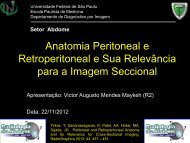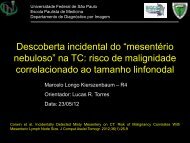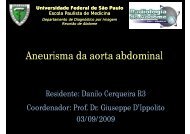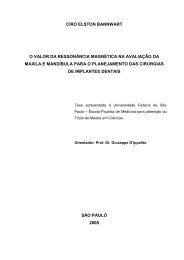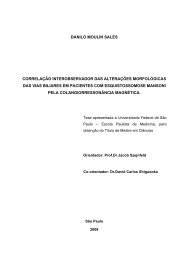leandro kfouri martins cerqueira análise ... - (DDI) - UNIFESP
leandro kfouri martins cerqueira análise ... - (DDI) - UNIFESP
leandro kfouri martins cerqueira análise ... - (DDI) - UNIFESP
You also want an ePaper? Increase the reach of your titles
YUMPU automatically turns print PDFs into web optimized ePapers that Google loves.
Abstract<br />
Purpose: To investigate the mandibular asymmetry cause of an individual with Class II<br />
subdivision malocclusion, through a cephalometric analysis made on frontal digital<br />
teleradiography. The aim was also to provide, through the results of cephalometric<br />
analysis, subsidies to the professionals to a better diagnosis and treatment plan of<br />
patients with Class II subdivision malocclusion. Methods: The sample consisted of 30<br />
individuals presenting Class II subdivision malocclusion. Frontal digital<br />
teleradiographies were performed and five main points were demarcated (17 - center<br />
point on top of the head of left condyle, 28 - center point on top of the head of right<br />
condyle, 23 - the deepest point in the right antegonial notch, 21 - deepest point on the<br />
left antegonial notch, and 22 - lower point in the mandibular symphysis). Sixteen<br />
secondary points were used in the cephalometric analysis. A digital system (Radiocef ®<br />
4.9) was used to point assessment, which determined the lines, plans and measures<br />
necessary to verify the origin of mandibular asymmetry present in an individual with a<br />
Class II subdivision malocclusion. Results: The results showed that there is a greater<br />
tendency of mandibular asymmetry of dental cause in malocclusion subdivision Class II<br />
conditions, however the orthodontist should give special attention to the sides of the<br />
base of the mandible, since the results found in this cephalometric study showed a<br />
greater linear difference comparing one against another attempting to a possible<br />
skeletal cause of mandibular asymmetry. Conclusions: The cephalometric analysis<br />
used in this study confirmed the clinical need for diagnosis and orthodontic treatment<br />
plan for individuals with Class II subdivision malocclusion, it is a simplified method that<br />
induces the professional to use complementary tests (clinical and photographic<br />
examination, analysis of models and CT) in cases where the cephalometric results<br />
showed a trend of a mandibular asymmetry of skeletal cause, since in most cases of<br />
malocclusion division Class II the individual is treated as if the mandibular asymmetry<br />
was always of dental cause.



